The Exped Synmat 7 UL (ultralite / ultralight) is a new inflatable sleeping pad / camping mattress from Exped. My wife and I have been using two of them for the last nine months as we have cycled from the UK to Asia. This review is based on our experiences with them and 15 years of sleeping outdoors on various pads and mats.
In the UK, Exped Synmats are available from All Outdoor (cheapest), Snow+Rock and on Amazon.co.uk. In America, you can get them from REI.com and Amazon.com.
[divide]
Overview
I consider that there are three broad categories of camping mat: foam, self-inflating and inflatable (see my comprehensive Comparison of Camping Mats article for more on this). Exped are probably the leading company in the manufacture of the latter – inflatable sleeping pads – and best known for their DownMats from which the Synmat differs only in its use of synthetic filling.
The Synmat airpad is an ultralight camping mat (less than 450g/16oz) that packs very small (size of a small water bottle) but which inflates to a large rectangular shape, long, wide and very thick.
Inflating and Deflating the Exped Synmat
The mat has two valves. On our first model these were red for deflating, green for inflating. On the newer model, the green valve also has a thin rubber spike sticking out which seems to help stop air leaking out during inflation; and the formerly red valve is now more or less just a transparent hole. The old red valve takes a minute or two to deflate, sped up by squeezing. The newer transparent valve deflates instantly.
You can inflate the mat with your mouth but it’s better to use a separate pump or inflation bag (see below for a full comparison of the options).
Sleeping Size of the Exped Synmat UL
These sleeping pads are very generous in their sizing, longer and wider than many. They are also rectangular rather than tapered or shaped like a coffin. This, along with their thickness, contributes to indulgent feeling of luxury you get when sleeping on one. In fact, they are so big that in our case, put side-by-side, they fill the entire tent floor from side to side (though not lengthways as we have the 3/4 length version). This might be an issue for those who enjoy space in their tent.
The “small” is much longer than most “3/4 length” mats. It’s over 5-foot so may be long enough on its own for many people.

Exped Synmat Effective Warmth
We have slept on ours in temperatures from around +35C to -15C (95 to 5F). It is difficult to make a meaningful judgement on the mats in isolation when they are combined with a particular type of tent and certain sleeping bags (and, in our case, additional foam pads, albeit super thin).
However, we have not once felt the cold from beneath us which is a common occurence when using other mats in winter. Similarly, when pitching the tents on those icy Turkish winter nights, it was an instant relief to get on top of one of those inflated mats.
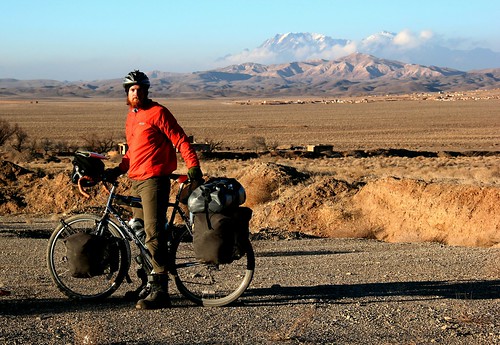
Their R-value is 3.1 and thus the lowest of the Exped inflatable range but even these are easily the warmest mats I have regularly used in winter.
Comfort Sleeping on an Exped Synmat 7
The Exped inflatable mats are sufficiently comfortable to sleep on that I almost feel guilty that I am not really camping any more. They feel a bit like cheating.
Bumpy or jagged ground, uneven terrain and large lumps under the tent are all easily absored by 2.8 inches of cushion meaning that it’s easy to become lazy about choosing your spot because you know it’s going to be comfortable wherever you lie.
Weight and pack size (UL = ultralight)
The “UL” part of the mat’s name means “ultralight”. The Medium (Synmat UL 7 M) weighs 454 grams (16oz) and the Small (Synmat UL 7 S) weighs 397 grams (14oz) . This is impressive. They are almost as low as the lightest self-inflating mats but much bigger, significantly warm and infinitely more comfortable. Their packsize is surprisingly small, larger than the smallest 3/4-length Thermarest ProLite but not by a lot.
Ultralight kit tends to be more expensive than its regular counterparts but, in this instance, the Synmat UL is actually cheaper. That’s presumably because the weight saving is achieved by using a much thinner material which makes it look and feel much more fragile. Which it probably is…

Strength and robustness
We have used our Synmat 7 UL air pad for nine months of camping at the side of the road, in car parks, garages, spare rooms, storage rooms, bed rooms and park benches.We protect ours with a very thin (2mm) foam sleeping pad underneath. We had one slow puncture in Iran, six months into the trip, that was fixed with the puncture repair kit included with every mat. I just had to put some glue on, let it dry, and repeat twice. I’ve had no problems since.
More seriously, however, one of the mats began to “delaminate” in Korea after eight months of use. The mat is comprised of several long ribs. When it delaminates, that means the seal of one of the ribs tears away with the result being a large lump appearing. I think we have may brought this problem on ourselves a little by routinely over-inflating the bags – liking a hard mattress, I would try my best each night to force as much air into them as possible. Anyway, the mats come with a two-year guarantee and our replacement was swiftly shipped to Japan. In the meantime, we under-inflated the mat and it was fine to use.
[divide]
Where to Buy Exped SynMats
Use the following links to have a look at ordering a Synmat online:
[one_half]
Buying in the UK
[button color=”green” link=”http://tinyurl.com/p3eexnn” align=”center” radius=”6″ size=”medium”]Check Prices at All Outdoor >>[/button]
[button color=”green” link=”http://www.amazon.co.uk/s/?_encoding=UTF8&camp=1634&creative=19450&field-keywords=exped%20synmat%20ul%207&linkCode=ur2&rh=i%3Aaps%2Ck%3Aexped%20synmat%20ul%207&tag=thenexcha0b-21&url=search-alias%3Daps” align=”center” radius=”6″ size=”medium”]Check Prices on Amazon.co.uk >>[/button]
You can also search for Exped Synmats on eBbay.co.uk
[/one_half]
[one_half_last]
Buying in the USA
[button color=”blue” link=”http://bit.ly/1uJnkjm” align=”center” radius=”6″ size=”medium”]Check Prices at REI >>[/button]
[button color=”blue” link=”http://www.amazon.com/mn/search/?_encoding=UTF8&camp=1789&creative=390957&field-keywords=exped%20synmat%20ul%207&linkCode=ur2&tag=thne0db-20&url=search-alias%3Daps&linkId=2EOQIMHX6KA2W7MA” align=”center” radius=”6″ size=”medium”]Check Prices on Amazon.com >>[/button]
You can also search Exped Synmats on eBay.com
[/one_half_last]
[divide]
PART TWO:
Best Inflation Method for Exped mats
Mini hand/pillow pump vs Schnozzel/Compression inflataion bags
Built-in hand pump (CPR method)
Some models of Exped mats (non-ultralight ones) have a pump built into one corner of the mat. By opening/closing the appropriate valves and lying the mat flat on the ground, you can push down with both hands repeatedly to inflate the mat. The action is much like CPR resuscitation. It is a neat system having everything built in although the process is quite slow and, I suspect, it will be tricky to fix/replace if anything goes wrong.
Lightweight Exped models have two separate valves: a green inflation valve and a red deflation valve. This gives you a variety of options for inflation. We’ve more or less used all of the different inflation options so can give an overview of how effective each is…
Blowing up with mouth/lungs
You can, of course, simply pucker up and evacuate your lungs into the green valve to inflate the mats. Unfortunately, being that bit more voluminous than the self-inflating mats most people are used to, these require a lot of air. It’s quite hard work to inflate even the 3/4 length (small) mat and tended to leave me feeling light-headed.
Moreover, your breath contains moisture and that moisture will get stuck inside your mat. This is worse for down mats – which may never recover their full loft after getting wet – but best to avoid with synthetic versions too.
Summary: Back up only. Good to know that you can inflate the mat easily if you forget/lose your inflation bag/pump but not for regular practice.
(N.B. All of the Exped inflation accessories described below come inside a neat little plastic zip-lock bag which Exped say they have made deliberately tough so that even the packaging is useful. They’re right. We’ve been using our zip-lock bag to carry all of our herbs, spices and kitchen kit for 8 months. Nice touch Exped!)
Hand pump (Exped Mini Pump)
We first tried the small foam Exped Mini Pump. This is just like a big round sponge that you connect with a small hose and repeatedly squash the air out of to inflate the mat. It’s simple and easy to use but takes a long time to inflate fully. It can be quite frustrating, hunching over the pump for five minutes unable to make it work any faster as you have to wait for the sponge to refill after each compression.
Summary: Easy to use and works fine but slow and a bit frustrating.
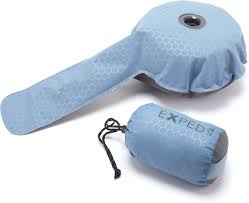
Pillow pump (Exped Pillow Pump)
The Exped Pillow Pump is an inflatable pillow which doubles as a pump, much like the Exped Mini Pump. I’ve not used this one but I would be pretty confident in saying that if you want an inflatable pillow then this is a great solution but if you don’t want an inflatable pillow then it’s the biggest and heaviest pump and probably not nearly as fast as the inflation bags.
Summary: Good if you want a pillow, not if you don’t.
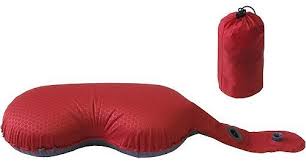
Inflation bag (Exped Schnozzel PumpBag & Waterproof Compression Bag ULV)
After a month of using the Mini Pump we decided to try an inflation bag, specifically the Exped Schnozzel Pump Bag. It was an excellent decision.
There are two of types of inflation bag: the Schnozzel PumpBag and the Waterproof Compression Bag ULV which also doubles as a storage sack for the mats. After connecting them to the mat by a small hose, you then open the bag up, fill it with air, roll the top down to seal it with air then squeeze the air out of the bag and into the mat. Three or four bags full of air and your mat is done.
This is much faster than any of the other methods and far less boringly repetitive than pumping by hand. The bags are also small and lighter than the pump and, if you use the Waterproof Compression Bag then you are killing a few birds with one stone.
Summary: Fastest and best option.
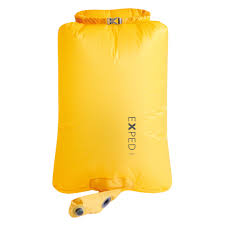
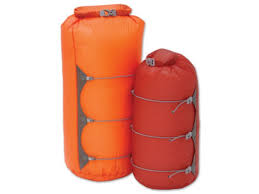
Buying Exed inflation bags and pumps
Buy in the UK from eBay.co.uk >>
ABuy in the UK from Amazon.co.uk >>
Buy in the USA from REI.com >>
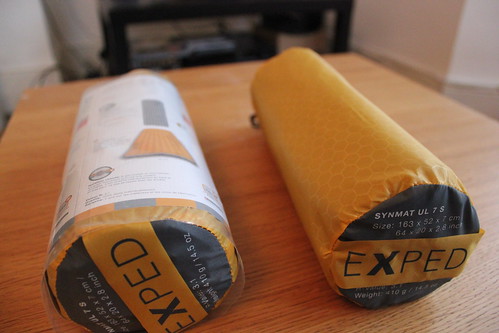
What do you think? Please do add your thoughts below…